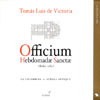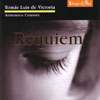Victoria Officium Hebdomadae Sanctae
A significant addition to the Victoria discography, and an effective Requiem
View record and artist detailsRecord and Artist Details
Composer or Director: Tomás Luis de Victoria
Genre:
Vocal
Label: Glossa
Magazine Review Date: 11/2005
Media Format: CD or Download
Media Runtime: 197
Mastering:
Stereo
DDD
Catalogue Number: GCD922002/3

Tracks:
| Composition | Artist Credit |
|---|---|
| Officium Hebdomade Sanctae - Dominica in Ramis Palmarum |
Tomás Luis de Victoria, Composer
(La) Colombina Ensemble Schola Antiqua Tomás Luis de Victoria, Composer |
| Officium Hebdomade Sanctae - Feria Quinta . In Coena Domini |
Tomás Luis de Victoria, Composer
(La) Colombina Ensemble Schola Antiqua Tomás Luis de Victoria, Composer |
| Officium Hebdomade Sanctae - Feria Sexta . In Passione Domini |
Tomás Luis de Victoria, Composer
(La) Colombina Ensemble Schola Antiqua Tomás Luis de Victoria, Composer |
| Officium Hebdomade Sanctae - Sabbato Sancto |
Tomás Luis de Victoria, Composer
(La) Colombina Ensemble Schola Antiqua Tomás Luis de Victoria, Composer |
Composer or Director: Tomás Luis de Victoria
Genre:
Vocal
Label: Deux-Elles
Magazine Review Date: 11/2005
Media Format: CD or Download
Media Runtime: 53
Mastering:
Stereo
DDD
Catalogue Number: DXL1112

Tracks:
| Composition | Artist Credit |
|---|---|
| Officium defunctorum |
Tomás Luis de Victoria, Composer
Armonico Consort Christopher Monks, Conductor Tomás Luis de Victoria, Composer |
Author: Fabrice Fitch
This sensible strategy works well, reconciling the complete presentation of the publication’s contents with a more contextually sensitive approach. To the extent that both aims are fulfilled, this recording takes its place as one of the most significant contributions to Victoria’s already impressive discography. It’s worth mentioning Victoria’s use of a handful of simple recurring motifs (usually associated with specific words or phrases) that he would no doubt have expected his listeners to recognise. A recording such as this is probably the only way to experience the cumulative effect of such a strategy, now that actual liturgical performances within Holy Week are a thing of the past.
As to the performances, the polyphony is polished and involving in equal measure, although the emotional intensity associated with Victoria seems inversely proportional to the number of singers used. (They respond particularly well to the pieces scored for high voices, surely some of the most memorable music here). While the inclusion of plainchant is both logical and effective, the manner in which it is sung is nearer to Solemnes than to the metrical approach that has sometimes been urged (and put into practice) for this period. The recording achieves a good presence, however, and enhances the performance’s ambient qualities.
The Armonico Consort’s recording is more straightforward, including as it does the famous Requiem and several related motets (among them Alfonso Lobo’s setting of Versa est in luctum alongside Victoria’s own). The ensemble is a mixed choir of about 20 singers, and their approach to Victoria is typical of the English choral tradition. This is clearly a conducted reading, though (to be fair) not overly obtrusive in its direction; tempi in the Requiem are broad but well sustained in the Introit, Kyrie and the closing movements, and rather brisker in the Gradual and Offertory, with only a very occasional hint of shrillness in the highest register, and of ill-assorted vibrato among the male soloists. (There appears also to have been an ill-chosen edit at 2’00” of the Sanctus.) These rare moments apart, the result is very effective, though in a relatively crowded field there may admittedly be readings more technically accomplished or affectively searching.
Discover the world's largest classical music catalogue with Presto Music.

Gramophone Digital Club
- Digital Edition
- Digital Archive
- Reviews Database
- Full website access
From £8.75 / month
Subscribe
Gramophone Full Club
- Print Edition
- Digital Edition
- Digital Archive
- Reviews Database
- Full website access
From £11.00 / month
Subscribe
If you are a library, university or other organisation that would be interested in an institutional subscription to Gramophone please click here for further information.




